中国奢侈品进出口状况剖析
中国奢侈品市场分析

中国奢侈品市场分析一、市场概况中国奢侈品市场是指中国大陆地区的高端消费品市场,包括奢侈品服装、配饰、手表、珠宝、化妆品、汽车等。
近年来,中国奢侈品市场呈现出快速增长的趋势,成为全球奢侈品品牌争相进入的重要市场之一。
二、市场规模根据相关数据统计,2019年中国奢侈品市场总销售额达到5000亿元人民币,同比增长15%。
其中,奢侈品服装和配饰占据了市场的主要份额,而奢侈品手表、珠宝和化妆品等也呈现出较快的增长势头。
三、市场消费群体中国奢侈品市场的消费群体主要包括高收入人群、企业高管、富二代、名人和明星等。
随着中国经济的快速发展和人民生活水平的提高,越来越多的人开始追求奢侈品的消费体验。
四、品牌竞争中国奢侈品市场是一个充满激烈竞争的市场,众多国际奢侈品品牌纷纷进入中国市场,与本土奢侈品品牌展开竞争。
国际品牌如LV、Gucci、Chanel等在中国市场占据一定的市场份额,而本土品牌如周大福、玉兰油等也在市场上取得了一定的成绩。
五、市场趋势1. 个性化消费:消费者对奢侈品的需求越来越个性化,品牌需要根据消费者的需求进行定制化服务,提供个性化的产品和购物体验。
2. 数字化转型:随着互联网的普及,奢侈品品牌需要加快数字化转型,通过线上渠道和社交媒体等方式与消费者进行互动和销售。
3. 二线城市崛起:随着一线城市市场的饱和,二线城市的消费潜力逐渐释放,成为奢侈品品牌争夺的重要市场。
4. 跨界合作:奢侈品品牌与其他行业进行跨界合作,如与艺术家、设计师、明星等合作推出联名款,增加品牌的独特性和吸引力。
六、市场挑战1. 假冒产品:中国奢侈品市场存在大量的假冒产品,给品牌正版产品的销售和声誉造成了一定的冲击。
2. 品牌饱和:中国奢侈品市场的品牌数量越来越多,市场竞争激烈,品牌需要不断提升产品质量和服务水平,以保持竞争优势。
3. 消费者心理变化:随着消费者观念的变化,一些消费者开始追求简约、环保和可持续发展的奢侈品,品牌需要及时调整产品和营销策略以满足消费者需求。
2021年中国箱包发展现状及进出口状况分析

2021年中国箱包发展现状及进出口状况分析一、中国箱包市场发展现状箱包是对袋子的统称,是用来装东西的各种物品的统称,包括手提包、钱包、背包、单肩包、挎包、腰包和衣箱、提箱、多种拉杆箱等。
主要因2020年新冠疫情的影响,人们出行受到抑制,加之箱包不属于必需品,箱包需求自然也随之减少。
2020年全年我国箱包市场成交额为240亿元,同比减少约66%。
我国国内箱包市场自2017年以来发展相当迅猛,2018-2020年间箱包市场维持在9000-11500个左右,2020年箱包市场数量为10081个,较上年减少11.2%。
二、箱包进出口贸易情况我国箱包产业多年以来一直处于出口大于进口的状态。
中国海关数据显示,2021年我国箱包产品进口金额63.6亿美元,出口金额278.6亿美元,贸易顺差为215亿美元,进出口金额较2020年均有所增长。
中国进口箱包主要源自意大利、法国等国家。
2021年我国从意大利进口箱包27.19亿美元;从法国进口箱包18.63亿美元。
主要原因是意大利、法国自文艺复兴时期起制作箱包等各类皮革制品,有着悠久的历史,加之浪漫的情调,浓烈的艺术氛围,产生了大量奢侈品箱包品牌。
如法国的LouisVuitton、Dior、Chanel、Hermes;意大利的PRADA、GUCCI等。
根据中国海关数据,中国箱包主要进口省市集中在经济条件较好的省市。
从进口箱包的金额来看,上海占据了绝对的大头,2021年上海进口箱包金额超过50亿美元,约占全国进口箱包金额的78%以上;其次分别为广东2.78亿美元;海南3.67亿美元;北京1.17亿美元。
从我国箱包出口金额来看,2021年我国箱包出口目的地主要集中在美国、日本、韩国、英国、德国等发达国家及地区。
其中我国2021年出口美国金额为54.75亿美元;出口日本金额为22.51亿美元;出口韩国金额为12.41亿美元。
我国箱包出口省市主要集中在广东、浙江、山东、福建、湖南、江苏等地区。
中国奢侈品发展和消费现状
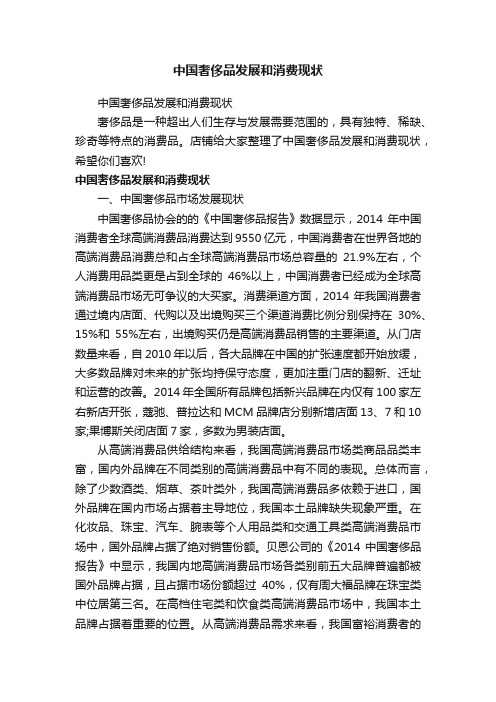
中国奢侈品发展和消费现状中国奢侈品发展和消费现状奢侈品是一种超出人们生存与发展需要范围的,具有独特、稀缺、珍奇等特点的消费品。
店铺给大家整理了中国奢侈品发展和消费现状,希望你们喜欢!中国奢侈品发展和消费现状一、中国奢侈品市场发展现状中国奢侈品协会的的《中国奢侈品报告》数据显示,2014年中国消费者全球高端消费品消费达到9550亿元,中国消费者在世界各地的高端消费品消费总和占全球高端消费品市场总容量的21.9%左右,个人消费用品类更是占到全球的46%以上,中国消费者已经成为全球高端消费品市场无可争议的大买家。
消费渠道方面,2014年我国消费者通过境内店面、代购以及出境购买三个渠道消费比例分别保持在30%、15%和55%左右,出境购买仍是高端消费品销售的主要渠道。
从门店数量来看,自2010年以后,各大品牌在中国的扩张速度都开始放缓,大多数品牌对未来的扩张均持保守态度,更加注重门店的翻新、迁址和运营的改善。
2014年全国所有品牌包括新兴品牌在内仅有100家左右新店开张,蔻驰、普拉达和MCM品牌店分别新增店面13、7和10家;果博斯关闭店面7家,多数为男装店面。
从高端消费品供给结构来看,我国高端消费品市场类商品品类丰富,国内外品牌在不同类别的高端消费品中有不同的表现。
总体而言,除了少数酒类、烟草、茶叶类外,我国高端消费品多依赖于进口,国外品牌在国内市场占据着主导地位,我国本土品牌缺失现象严重。
在化妆品、珠宝、汽车、腕表等个人用品类和交通工具类高端消费品市场中,国外品牌占据了绝对销售份额。
贝恩公司的《2014中国奢侈品报告》中显示,我国内地高端消费品市场各类别前五大品牌普遍都被国外品牌占据,且占据市场份额超过40%,仅有周大福品牌在珠宝类中位居第三名。
在高档住宅类和饮食类高端消费品市场中,我国本土品牌占据着重要的位置。
从高端消费品需求来看,我国富裕消费者的数量在迅猛增长,预计2015年将超过400万,中国将成为仅次于美国、日本和英国的全球富裕家庭第四多的国家,富裕人群的增加将会有效的带动我国高端消费品的需求。
奢侈品行业现状-产业报告

奢侈品行业现状-产业报告2019年全球奢侈品市场销售额预计增长4%,其中中国奢侈品市场销售额预计增长26%,消费金额达984亿欧元。
我国奢侈品行业消费者主要集中在如北京、上海这样的一线城市及重庆、天津、成都、深圳等新一线和二线城市。
以下对奢侈品行业现状分析。
近年来,我国奢侈品行业市场规模不断增长,2018年我国奢侈品市场规模已达到1700亿元,奢侈品行业分析按照此趋势增长,2025年我国奢侈品市场规模或将突破4000亿元。
2015-2025年中国奢侈品行业市场规模统计及预测随着这些地区经济的崛起和居民消费能力的提升,偏好奢侈品的东亚居民迅速成长为全球奢侈品最重要的消费群体,但国内免税市场仍然非常有限。
现从三大市场状况来分析奢侈品行业现状。
奢侈品市场规模:随着人们消费水平的持续提升,人们对生活品质的要求也越来越高,与此同时对奢侈品的消费需求也在持续增长。
2019年我国中产阶层规模达到2.24亿人。
奢侈品行业现状这一数据表明当前我国中产阶层规模较大,并且我国中产阶层所支配的财富总值达到29.8万亿,我国中产阶层的财富总值占全球第一,然而在财富分配方面表现出“金字塔形”的组织形态。
即我国中产阶层中低财富的规模占很大比例,在金字塔顶端的寥寥无几,而美国与日本的中产阶层组织结构比较均衡,然而这部分“低财富”的中产阶层在奢侈品消费方面资金也非常富足。
综上,我国中产阶层已经形成一定规模,同时在购买奢侈品方面具备一定消费水平。
奢侈品消费者结构:我国作为全球奢侈品最大消费市场,消费者形态万千,奢侈品行业现状根据消费者特征基本可以划分成下述四类:期待群体、时尚达人、新富阶层和核心消费群体。
每一类型消费群体都具有明显的消费特点,其中消费比较稳定的是新富阶层以及核心消费群体,期待群体这一消费群体呈快上升趋势,时尚达人这一消费群体规模明显扩大,这也是近年来奢侈品消费群体迅速扩大的主要原因。
其次,最近几年我国奢侈品消费市场中女性消费者所占比例不断提高,1995年女性消费者比例仅为10个百分点,截至2019年,这个比例达到了52个百分点。
中国奢侈品进出口状况剖析
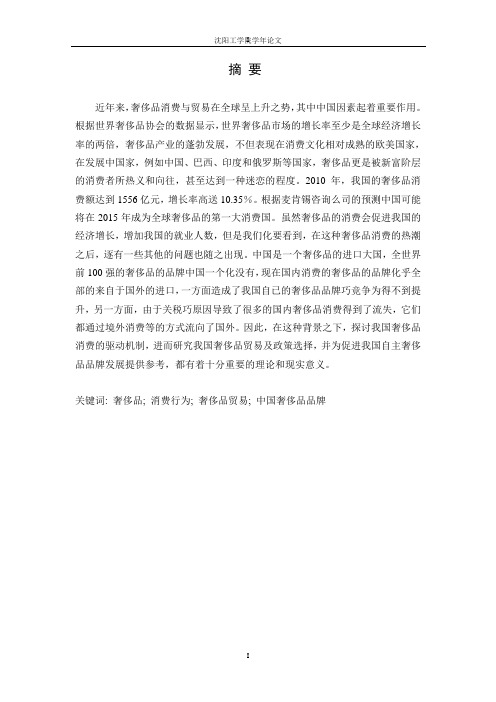
摘要近年来,奢侈品消费与贸易在全球呈上升之势,其中中国因素起着重要作用。
根据世界奢侈品协会的数据显示,世界奢侈品市场的增长率至少是全球经济增长率的两倍,奢侈品产业的蓬勃发展,不但表现在消费文化相对成熟的欧美国家,在发展中国家,例如中国、巴西、印度和俄罗斯等国家,奢侈品更是被新富阶层的消费者所热义和向往,甚至达到一种迷恋的程度。
2010年,我国的奢侈品消费额达到1556亿元,增长率高送10.35%。
根据麦肯锡咨询么司的预测中国可能将在2015年成为全球奢侈品的第一大消费国。
虽然奢侈品的消费会促进我国的经济增长,增加我国的就业人数,但是我们化要看到,在这种奢侈品消费的热潮之后,逐有一些其他的问题也随之出现。
中国是一个奢侈品的进口大国,全世界前100强的奢侈品的品牌中国一个化没有,现在国内消费的奢侈品的品牌化乎全部的来自于国外的进口,一方面造成了我国自已的奢侈品品牌巧竞争为得不到提升,另一方面,由于关税巧原因导致了很多的国内奢侈品消费得到了流失,它们都通过境外消费等的方式流向了国外。
因此,在这种背景之下,探讨我国奢侈品消费的驱动机制,进而研究我国奢侈品贸易及政策选择,并为促进我国自主奢侈品品牌发展提供参考,都有着十分重要的理论和现实意义。
关键词: 奢侈品; 消费行为; 奢侈品贸易; 中国奢侈品品牌AbstractSmall and medium-sized enterprise is an important part of the national economy, with its unique mode of operation and flexible production methods for economic development and social stability plays an important role in promoting. The small and medium-sized enterprises are quite part ignored in the financial management of the key position, and management thoughts, make enterprise administration rigid backward production operational management pattern to the role of enterprise financial management, no into full play. Meanwhile, the macroeconomic environment, due to the influence of changes and system, and small and medium-sized enterprises in strengthening financial management encountered some resistance.Here mainly from the small and medium-sized enterprises in financial management present situation, the modern financial management as the basis, through the analysis of the small and medium-sized enterprises, to find out the problems existing in the financial management, and to find out the causes of the existing problems and discusses the development of small and middle-sized enterprises financial management methods, improve financial management mechanism and enhance small and medium-sized enterprise management level. On this foundation, discuss enterprise under the new situation the development direction of financial management.Key words : Luxury ; Consumer behavior; Luxury trade; Chinese luxury brands绪论改革开放年来,随着中国经济的快速发展,居民收入水平的大幅增长,富裕人群的快速涌现,中国正逐步成为奢侈品消费市场的生力军。
中国奢侈品消费特点的现状及探析
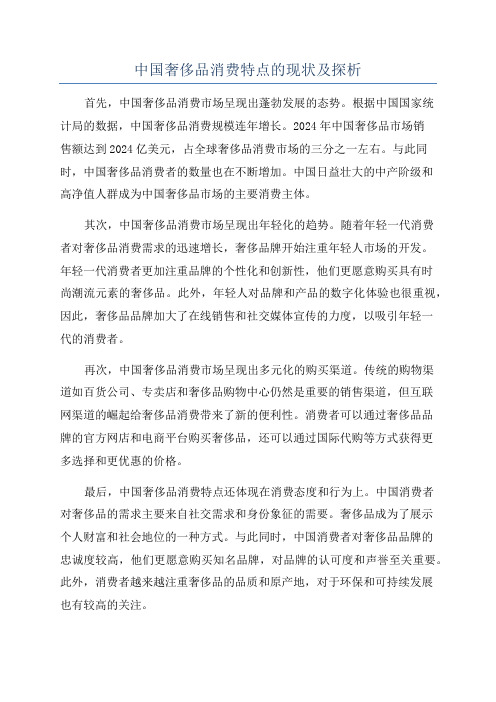
中国奢侈品消费特点的现状及探析首先,中国奢侈品消费市场呈现出蓬勃发展的态势。
根据中国国家统计局的数据,中国奢侈品消费规模连年增长。
2024年中国奢侈品市场销售额达到2024亿美元,占全球奢侈品消费市场的三分之一左右。
与此同时,中国奢侈品消费者的数量也在不断增加。
中国日益壮大的中产阶级和高净值人群成为中国奢侈品市场的主要消费主体。
其次,中国奢侈品消费市场呈现出年轻化的趋势。
随着年轻一代消费者对奢侈品消费需求的迅速增长,奢侈品牌开始注重年轻人市场的开发。
年轻一代消费者更加注重品牌的个性化和创新性,他们更愿意购买具有时尚潮流元素的奢侈品。
此外,年轻人对品牌和产品的数字化体验也很重视,因此,奢侈品品牌加大了在线销售和社交媒体宣传的力度,以吸引年轻一代的消费者。
再次,中国奢侈品消费市场呈现出多元化的购买渠道。
传统的购物渠道如百货公司、专卖店和奢侈品购物中心仍然是重要的销售渠道,但互联网渠道的崛起给奢侈品消费带来了新的便利性。
消费者可以通过奢侈品品牌的官方网店和电商平台购买奢侈品,还可以通过国际代购等方式获得更多选择和更优惠的价格。
最后,中国奢侈品消费特点还体现在消费态度和行为上。
中国消费者对奢侈品的需求主要来自社交需求和身份象征的需要。
奢侈品成为了展示个人财富和社会地位的一种方式。
与此同时,中国消费者对奢侈品品牌的忠诚度较高,他们更愿意购买知名品牌,对品牌的认可度和声誉至关重要。
此外,消费者越来越注重奢侈品的品质和原产地,对于环保和可持续发展也有较高的关注。
总的来说,中国奢侈品消费市场具有庞大的规模、年轻化的趋势、多元化的购买渠道和独特的消费特点。
随着中国经济的持续增长和中产阶级的扩大,中国奢侈品市场的发展潜力巨大,奢侈品品牌需要灵活应对市场变化,不断创新,以满足中国消费者不断升级的消费需求。
中国奢侈品市场分析
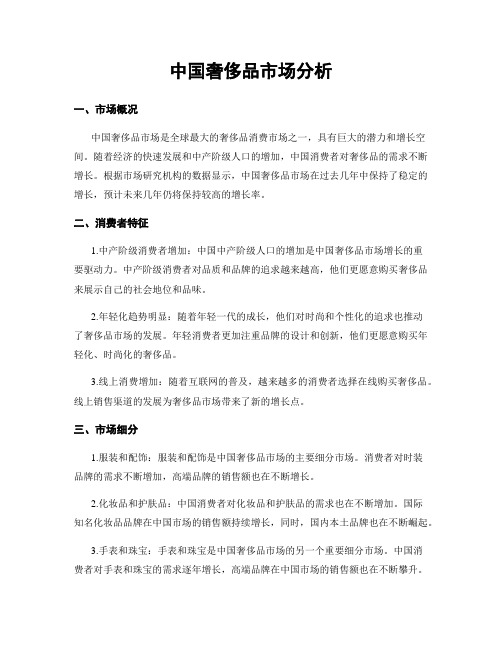
中国奢侈品市场分析一、市场概况中国奢侈品市场是全球最大的奢侈品消费市场之一,具有巨大的潜力和增长空间。
随着经济的快速发展和中产阶级人口的增加,中国消费者对奢侈品的需求不断增长。
根据市场研究机构的数据显示,中国奢侈品市场在过去几年中保持了稳定的增长,预计未来几年仍将保持较高的增长率。
二、消费者特征1.中产阶级消费者增加:中国中产阶级人口的增加是中国奢侈品市场增长的重要驱动力。
中产阶级消费者对品质和品牌的追求越来越高,他们更愿意购买奢侈品来展示自己的社会地位和品味。
2.年轻化趋势明显:随着年轻一代的成长,他们对时尚和个性化的追求也推动了奢侈品市场的发展。
年轻消费者更加注重品牌的设计和创新,他们更愿意购买年轻化、时尚化的奢侈品。
3.线上消费增加:随着互联网的普及,越来越多的消费者选择在线购买奢侈品。
线上销售渠道的发展为奢侈品市场带来了新的增长点。
三、市场细分1.服装和配饰:服装和配饰是中国奢侈品市场的主要细分市场。
消费者对时装品牌的需求不断增加,高端品牌的销售额也在不断增长。
2.化妆品和护肤品:中国消费者对化妆品和护肤品的需求也在不断增加。
国际知名化妆品品牌在中国市场的销售额持续增长,同时,国内本土品牌也在不断崛起。
3.手表和珠宝:手表和珠宝是中国奢侈品市场的另一个重要细分市场。
中国消费者对手表和珠宝的需求逐年增长,高端品牌在中国市场的销售额也在不断攀升。
四、品牌竞争1.国际品牌:国际奢侈品牌在中国市场具有较高的知名度和声誉,消费者对其品牌价值和品质有较高的认可度。
国际品牌通过不断推出适应中国市场需求的产品和营销策略,保持了在中国市场的竞争优势。
2.本土品牌:中国本土奢侈品品牌在近年来取得了显著的发展。
本土品牌通过结合中国传统文化和时尚元素,满足了一部分消费者对本土品牌的偏好。
五、市场发展趋势1.二三线城市潜力巨大:随着中国经济的快速发展,二三线城市的消费能力逐渐提升,这些城市成为奢侈品市场的新的增长点。
皮具进出口数据分析报告(3篇)
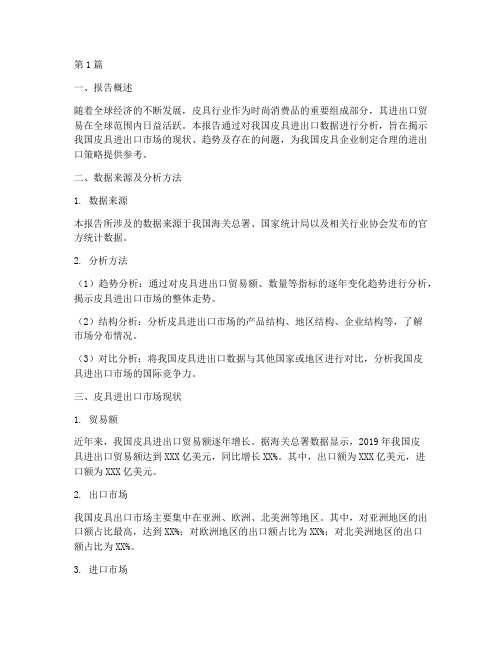
第1篇一、报告概述随着全球经济的不断发展,皮具行业作为时尚消费品的重要组成部分,其进出口贸易在全球范围内日益活跃。
本报告通过对我国皮具进出口数据进行分析,旨在揭示我国皮具进出口市场的现状、趋势及存在的问题,为我国皮具企业制定合理的进出口策略提供参考。
二、数据来源及分析方法1. 数据来源本报告所涉及的数据来源于我国海关总署、国家统计局以及相关行业协会发布的官方统计数据。
2. 分析方法(1)趋势分析:通过对皮具进出口贸易额、数量等指标的逐年变化趋势进行分析,揭示皮具进出口市场的整体走势。
(2)结构分析:分析皮具进出口市场的产品结构、地区结构、企业结构等,了解市场分布情况。
(3)对比分析:将我国皮具进出口数据与其他国家或地区进行对比,分析我国皮具进出口市场的国际竞争力。
三、皮具进出口市场现状1. 贸易额近年来,我国皮具进出口贸易额逐年增长。
据海关总署数据显示,2019年我国皮具进出口贸易额达到XXX亿美元,同比增长XX%。
其中,出口额为XXX亿美元,进口额为XXX亿美元。
2. 出口市场我国皮具出口市场主要集中在亚洲、欧洲、北美洲等地区。
其中,对亚洲地区的出口额占比最高,达到XX%;对欧洲地区的出口额占比为XX%;对北美洲地区的出口额占比为XX%。
3. 进口市场我国皮具进口市场主要集中在意大利、法国、西班牙、德国等欧洲国家。
其中,从意大利进口的皮具金额最高,占比达到XX%;从法国进口的皮具金额占比为XX%;从西班牙进口的皮具金额占比为XX%。
4. 产品结构我国皮具出口产品以皮包、皮带、皮鞋等为主,其中皮包出口额占比最高,达到XX%;皮带出口额占比为XX%;皮鞋出口额占比为XX%。
在进口产品中,以皮包、皮带、皮鞋等高端产品为主,其中皮包进口额占比最高,达到XX%;皮带进口额占比为XX%;皮鞋进口额占比为XX%。
四、皮具进出口市场趋势1. 市场需求增长随着全球消费水平的提升,皮具市场需求持续增长。
特别是在我国,随着居民收入水平的提高,皮具消费需求逐年增加。
奢侈品行业分析
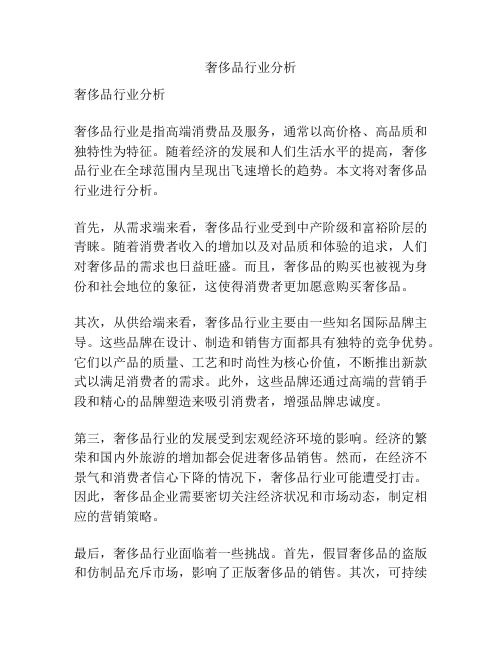
奢侈品行业分析奢侈品行业分析奢侈品行业是指高端消费品及服务,通常以高价格、高品质和独特性为特征。
随着经济的发展和人们生活水平的提高,奢侈品行业在全球范围内呈现出飞速增长的趋势。
本文将对奢侈品行业进行分析。
首先,从需求端来看,奢侈品行业受到中产阶级和富裕阶层的青睐。
随着消费者收入的增加以及对品质和体验的追求,人们对奢侈品的需求也日益旺盛。
而且,奢侈品的购买也被视为身份和社会地位的象征,这使得消费者更加愿意购买奢侈品。
其次,从供给端来看,奢侈品行业主要由一些知名国际品牌主导。
这些品牌在设计、制造和销售方面都具有独特的竞争优势。
它们以产品的质量、工艺和时尚性为核心价值,不断推出新款式以满足消费者的需求。
此外,这些品牌还通过高端的营销手段和精心的品牌塑造来吸引消费者,增强品牌忠诚度。
第三,奢侈品行业的发展受到宏观经济环境的影响。
经济的繁荣和国内外旅游的增加都会促进奢侈品销售。
然而,在经济不景气和消费者信心下降的情况下,奢侈品行业可能遭受打击。
因此,奢侈品企业需要密切关注经济状况和市场动态,制定相应的营销策略。
最后,奢侈品行业面临着一些挑战。
首先,假冒奢侈品的盗版和仿制品充斥市场,影响了正版奢侈品的销售。
其次,可持续性和环保问题也成为消费者越来越关注的议题,奢侈品企业需要采取可持续发展的经营模式来应对。
此外,新兴市场的崛起也给传统奢侈品品牌带来了竞争压力,他们需要寻找新的增长点和市场机会。
总之,奢侈品行业在全球范围内迅速发展,并且具有广阔的市场前景。
然而,企业需要密切关注消费者需求和市场动态,不断创新和适应变化,才能在竞争激烈的市场中取得成功。
同时,企业还需要注重可持续发展和品牌形象的塑造,以提高市场竞争力。
中国奢侈品行业宏观环境分析

中国奢侈品行业宏观环境分析一、政治环境(1) 税收政策2006年出台的消费税调整方案增加或提高了对游艇、高尔夫球具及高档手表等奢侈品的消费税,这使得原本就比海外市场价格高出10%-20%的奢侈品价格又有所提高。
这一政策的出台直接导致我国内地消费者增加了在境外旅游时购买奢侈品的需求。
这种情况对我国奢侈品产业的培养起到一定的积极意义:在利润空间有所下降的同时,他们可能就会考虑到利用范围经济的优势,选择一些仅在国内小有名气的品牌来代理,这样的品牌没有足够讨价还价的能力,反而会给经销商留出更多的利润空间。
而国内品牌就可以通过这样的方式分享到国际水平的宣传和管理资源,这对国产品牌初期的销售渠道的培养和今后市场的开拓是有积极意义的。
(2) 大力支持自主品牌发展商务部采取了树立自主品牌典型、提供政策支持等六大措施,大力实施品牌战略。
一是树立一批自主品牌的典型。
二是为品牌企业提供必要的政策支持。
三是帮助企业进行品牌宣传。
四是推动名牌企业“走出去”。
五是开展“品牌万里行”活动。
六是加大自主品牌知识产权保护力度。
这一系列措施的实施将对我国培养自主奢侈品牌起到积极的意义。
(3) 加强知识产权保护意识和相关法律对维护品牌权益要发展奢侈品产业,首先要保证奢侈品品牌的权益,所以一国的品牌权益保护力度和有效性将直接影响该国奢侈品产业的发展。
2006年12月,在中央经济工作会议上,胡锦涛总书记强调,要加快建立健全知识产权保护体系,形成一批拥有自主知识产权的产品和世界知名品牌。
二、经济环境如果把2009 年第一季度换算成年率GDP 降幅横向比较:美国负6.1%,欧元区16 国平均约负10%,德国负14.4%。
而我们的近邻日本2008 财政年度的实际GDP 增长率为负3.5%,是近7 年来首次遭遇负增长,已经超过1998 年度的负1.5%,创下战后最差纪录,今年又因负15.2%登上发达国家经济负增长榜首。
对比中国8%的惊人GDP,中国真是创造了又一个奇迹。
中国奢侈品消费市场分析及对策建议论文
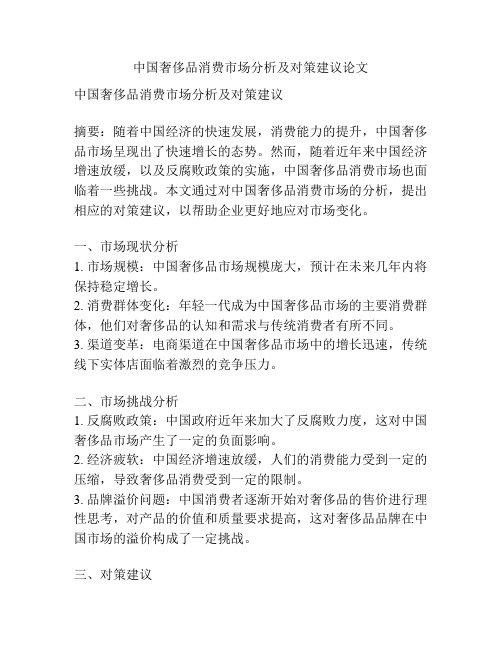
中国奢侈品消费市场分析及对策建议论文中国奢侈品消费市场分析及对策建议摘要:随着中国经济的快速发展,消费能力的提升,中国奢侈品市场呈现出了快速增长的态势。
然而,随着近年来中国经济增速放缓,以及反腐败政策的实施,中国奢侈品消费市场也面临着一些挑战。
本文通过对中国奢侈品消费市场的分析,提出相应的对策建议,以帮助企业更好地应对市场变化。
一、市场现状分析1. 市场规模:中国奢侈品市场规模庞大,预计在未来几年内将保持稳定增长。
2. 消费群体变化:年轻一代成为中国奢侈品市场的主要消费群体,他们对奢侈品的认知和需求与传统消费者有所不同。
3. 渠道变革:电商渠道在中国奢侈品市场中的增长迅速,传统线下实体店面临着激烈的竞争压力。
二、市场挑战分析1. 反腐败政策:中国政府近年来加大了反腐败力度,这对中国奢侈品市场产生了一定的负面影响。
2. 经济疲软:中国经济增速放缓,人们的消费能力受到一定的压缩,导致奢侈品消费受到一定的限制。
3. 品牌溢价问题:中国消费者逐渐开始对奢侈品的售价进行理性思考,对产品的价值和质量要求提高,这对奢侈品品牌在中国市场的溢价构成了一定挑战。
三、对策建议1. 适应年轻一代消费者的需求:年轻一代对于奢侈品的需求更加注重时尚性、个性化和体验感,企业应该加强与年轻人的沟通,提供符合他们需求的产品和服务。
2. 加大线上销售渠道的力度:电商渠道逐渐成为奢侈品消费的主要渠道之一,企业应积极拓展线上市场,并运用互联网技术提升用户体验。
3. 提供更高性价比的产品:随着消费者对奢侈品品牌溢价的关注度增加,企业应注重产品的价值和质量,提供更加具有性价比的产品,以满足消费者的需求。
4. 强化品牌形象和文化:奢侈品在中国市场的成功离不开一定的品牌形象和文化积淀,企业应该加大对品牌形象和文化的建设力度,并通过营销手段将其传达给消费者。
5. 积极拓展二三线市场:中国二三线城市的消费潜力巨大,企业应积极拓展这些市场,以寻找新的增长点。
奢侈品行业年终总结:市场表现与品牌竞争力
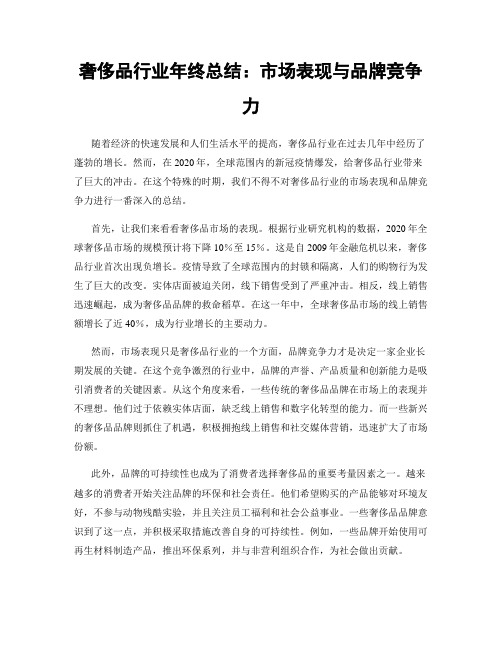
奢侈品行业年终总结:市场表现与品牌竞争力随着经济的快速发展和人们生活水平的提高,奢侈品行业在过去几年中经历了蓬勃的增长。
然而,在2020年,全球范围内的新冠疫情爆发,给奢侈品行业带来了巨大的冲击。
在这个特殊的时期,我们不得不对奢侈品行业的市场表现和品牌竞争力进行一番深入的总结。
首先,让我们来看看奢侈品市场的表现。
根据行业研究机构的数据,2020年全球奢侈品市场的规模预计将下降10%至15%。
这是自2009年金融危机以来,奢侈品行业首次出现负增长。
疫情导致了全球范围内的封锁和隔离,人们的购物行为发生了巨大的改变。
实体店面被迫关闭,线下销售受到了严重冲击。
相反,线上销售迅速崛起,成为奢侈品品牌的救命稻草。
在这一年中,全球奢侈品市场的线上销售额增长了近40%,成为行业增长的主要动力。
然而,市场表现只是奢侈品行业的一个方面,品牌竞争力才是决定一家企业长期发展的关键。
在这个竞争激烈的行业中,品牌的声誉、产品质量和创新能力是吸引消费者的关键因素。
从这个角度来看,一些传统的奢侈品品牌在市场上的表现并不理想。
他们过于依赖实体店面,缺乏线上销售和数字化转型的能力。
而一些新兴的奢侈品品牌则抓住了机遇,积极拥抱线上销售和社交媒体营销,迅速扩大了市场份额。
此外,品牌的可持续性也成为了消费者选择奢侈品的重要考量因素之一。
越来越多的消费者开始关注品牌的环保和社会责任。
他们希望购买的产品能够对环境友好,不参与动物残酷实验,并且关注员工福利和社会公益事业。
一些奢侈品品牌意识到了这一点,并积极采取措施改善自身的可持续性。
例如,一些品牌开始使用可再生材料制造产品,推出环保系列,并与非营利组织合作,为社会做出贡献。
在品牌竞争力方面,中国市场的崛起不容忽视。
中国已成为全球奢侈品消费的重要驱动力,中国消费者对奢侈品的需求持续增长。
然而,中国市场的竞争也日益激烈。
越来越多的国际奢侈品品牌进入中国市场,与本土品牌展开竞争。
在这个过程中,了解中国消费者的偏好和购物习惯变得至关重要。
外贸包包市场分析报告

外贸包包市场分析报告外贸包包市场分析报告一、市场概况外贸包包是指以出口为主要销售渠道的包包产品。
随着全球化的不断推进,外贸包包市场呈现出快速增长的趋势。
外贸包包市场的规模庞大,种类繁多,包括手提包、背包、钱包、旅行箱等多种产品。
二、市场特点1. 质量要求高:外贸包包的主要销售对象是国外客户,对产品的质量要求较高。
因此,外贸包包企业必须注重产品的品质,提高产品的质量标准,以赢得市场竞争力。
2. 波动性大:外贸包包市场受到国际经济形势的影响较大,国际贸易摩擦等因素会导致市场需求波动较大。
外贸包包企业需灵活应对市场变化,加强市场预测与调整,降低经营风险。
3. 个性化定制:外贸包包市场存在着大量的定制需求。
国外客户对产品的个性化需求较高,外贸包包企业应不断创新设计,提供定制化的服务,以满足客户的需求。
三、市场竞争分析外贸包包市场竞争激烈,主要竞争因素包括产品质量、价格、品牌知名度和服务水平等。
目前市场上主要存在以下几类竞争对手:1. 国内企业:国内包包企业在产品质量和价格上具有一定的竞争优势,但其在品牌知名度和服务水平上相对较弱。
国内包包企业需要加大品牌建设和服务提升力度,以提高市场竞争力。
2. 国外企业:国外包包品牌在品牌知名度和品质上具有较大优势,但其价格相对较高。
国外包包企业需要降低价格,开拓更多的销售渠道和市场,以扩大市场份额。
3. 电商平台:电商平台以其便捷的购物方式和多样化的产品选择,吸引了大量的消费者。
外贸包包企业可以借助电商平台的优势,拓展海外市场,提升销售额。
四、市场发展趋势1. 品质导向:随着消费者对产品品质要求的提高,外贸包包市场将趋向于品质导向。
外贸包包企业需要注重产品质量,加强质量管理,提高产品的附加值。
2. 定制化服务:客户个性化需求的增加将推动外贸包包市场向定制化服务的方向发展。
外贸包包企业可以通过多样化的设计和定制化的服务,满足客户的个性化需求。
3. 网络化销售:随着互联网的普及,网络销售将成为外贸包包企业的重要销售渠道。
奢侈品市场调查报告(精选多篇)
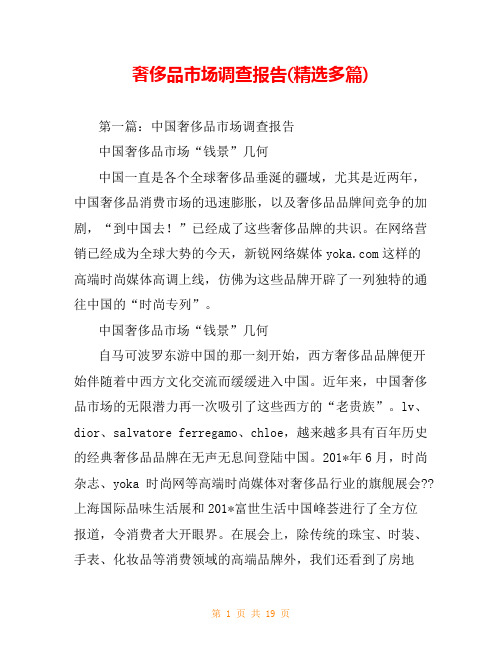
奢侈品市场调查报告(精选多篇)第一篇:中国奢侈品市场调查报告中国奢侈品市场“钱景”几何中国一直是各个全球奢侈品垂涎的疆域,尤其是近两年,中国奢侈品消费市场的迅速膨胀,以及奢侈品品牌间竞争的加剧,“到中国去!”已经成了这些奢侈品牌的共识。
在网络营销已经成为全球大势的今天,新锐网络媒体这样的高端时尚媒体高调上线,仿佛为这些品牌开辟了一列独特的通往中国的“时尚专列”。
中国奢侈品市场“钱景”几何自马可波罗东游中国的那一刻开始,西方奢侈品品牌便开始伴随着中西方文化交流而缓缓进入中国。
近年来,中国奢侈品市场的无限潜力再一次吸引了这些西方的“老贵族”。
lv、dior、salvatore ferregamo、chloe,越来越多具有百年历史的经典奢侈品品牌在无声无息间登陆中国。
201*年6月,时尚杂志、yoka时尚网等高端时尚媒体对奢侈品行业的旗舰展会??上海国际品味生活展和201*富世生活中国峰荟进行了全方位报道,令消费者大开眼界。
在展会上,除传统的珠宝、时装、手表、化妆品等消费领域的高端品牌外,我们还看到了房地产、汽车、旅游、私人游艇、飞机等行业领导者的风采。
更有甚者,把西方的名贵宠物犬也搬到了中国。
中国的奢侈品市场到底有多大?为何能吸引如此多的西方“贵族”纷至沓来?经济的繁荣造就了中国一大批百万富翁和不断扩大的中产阶层,速度之快令全球奢侈品巨头惊讶。
根据中国品牌策略协会公布的数据,中国有1.75亿消费者有能力购买各种品牌的奢侈品,而到201*年,这个数字将达到2.5亿,消费额也会从目前的20多亿美元增加到70亿美元。
摩根士丹利分析师克莱尔.肯特预计,中国的奢侈品消费者最终将达到1亿人,与日本不相上下,中国将成为全球最赚钱的奢侈品市场。
“数据显示,欧美奢侈品行业的市场年增长幅度只维持在10%左右”一位来自于中国首家高端时尚垂直门户、“奢适”生活的倡导者的资深行业人士认为,“对比之下,近3年来,许多奢侈品品牌在中国市场的增长率却达到了惊人的80%-100%,远远高于他们在世界其它国家和地区的增长率!”由此可以看出,除中国市场的巨大潜力外,国外奢侈品行业激烈的竞争也是导致奢侈品品牌大规模东游的原因之一。
谈我国对奢侈品的政策及现状
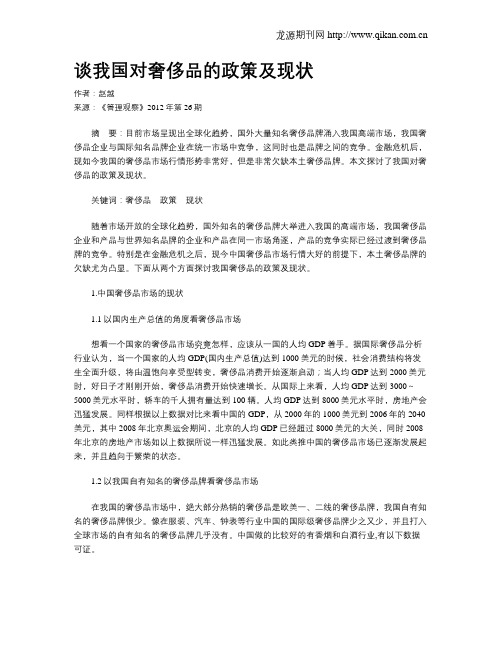
谈我国对奢侈品的政策及现状作者:赵越来源:《管理观察》2012年第26期摘要:目前市场呈现出全球化趋势,国外大量知名奢侈品牌涌入我国高端市场,我国奢侈品企业与国际知名品牌企业在统一市场中竞争,这同时也是品牌之间的竞争。
金融危机后,现如今我国的奢侈品市场行情形势非常好,但是非常欠缺本土奢侈品牌。
本文探讨了我国对奢侈品的政策及现状。
关键词:奢侈品政策现状随着市场开放的全球化趋势,国外知名的奢侈品牌大举进入我国的高端市场,我国奢侈品企业和产品与世界知名品牌的企业和产品在同一市场角逐,产品的竞争实际已经过渡到奢侈品牌的竞争。
特别是在金融危机之后,现今中国奢侈品市场行情大好的前提下,本土奢侈品牌的欠缺尤为凸显。
下面从两个方面探讨我国奢侈品的政策及现状。
1.中国奢侈品市场的现状1.1以国内生产总值的角度看奢侈品市场想看一个国家的奢侈品市场究竟怎样,应该从一国的人均GDP着手。
据国际奢侈品分析行业认为,当一个国家的人均GDP(国内生产总值)达到1000美元的时候,社会消费结构将发生全面升级,将由温饱向享受型转变,奢侈品消费开始逐渐启动;当人均GDP达到2000美元时,好日子才刚刚开始,奢侈品消费开始快速增长。
从国际上来看,人均GDP达到3000~5000美元水平时,轿车的千人拥有量达到100辆。
人均GDP达到8000美元水平时,房地产会迅猛发展。
同样根据以上数据对比来看中国的GDP,从2000年的1000美元到2006年的2040美元,其中2008年北京奥运会期间,北京的人均GDP已经超过8000美元的大关,同时2008年北京的房地产市场如以上数据所说一样迅猛发展。
如此类推中国的奢侈品市场已逐渐发展起来,并且趋向于繁荣的状态。
1.2以我国自有知名的奢侈品牌看奢侈品市场在我国的奢侈品市场中,绝大部分热销的奢侈品是欧美一、二线的奢侈品牌,我国自有知名的奢侈品牌很少。
像在服装、汽车、钟表等行业中国的国际级奢侈品牌少之又少,并且打入全球市场的自有知名的奢侈品牌几乎没有。
奢侈品现状及发展趋势分析报告
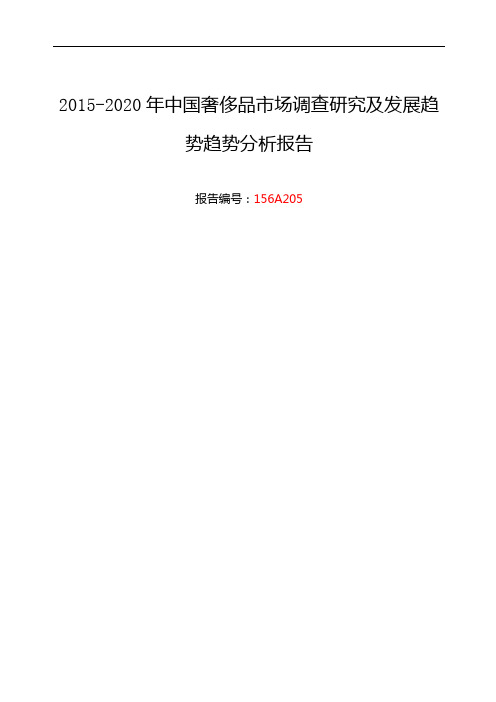
2015-2020年中国奢侈品市场调查研究及发展趋势趋势分析报告报告编号:156A205行业市场研究属于企业战略研究范畴,作为当前应用最为广泛的咨询服务,其研究成果以报告形式呈现,通常包含以下内容:一份专业的行业研究报告,注重指导企业或投资者了解该行业整体发展态势及经济运行状况,旨在为企业或投资者提供方向性的思路和参考。
一份有价值的行业研究报告,可以完成对行业系统、完整的调研分析工作,使决策者在阅读完行业研究报告后,能够清楚地了解该行业市场现状和发展前景趋势,确保了决策方向的正确性和科学性。
中国产业调研网基于多年来对客户需求的深入了解,全面系统地研究了该行业市场现状及发展前景,注重信息的时效性,从而更好地把握市场变化和行业发展趋势。
一、基本信息报告名称:2015-2020年中国奢侈品市场调查研究及发展趋势趋势分析报告报告编号:156A205 ←咨询时,请说明此编号。
优惠价:¥6750 元可开具增值税专用发票咨询电话:Email:网上阅读:温馨提示:如需英文、日文等其他语言版本,请与我们联系。
二、内容介绍随着我国经济的发展,消费者购买力的提高,奢侈品的消费份额也越来越大,凭借着稳定而又快速的经济增长,中国在成为世界经济中国的同时,也逐步发展了奢侈品消费大国,将中国消费者在海外的购买力计算在内,2009年中国奢侈品消费额已经超过日本,成为第二大奢侈品消费国。
中国产业调研网发布的2015-2020年中国奢侈品市场调查研究及发展趋势趋势分析报告认为:诱人的中国奢侈品市场,引得众多国际奢侈品品牌纷纷“抢滩”中国,连原本只在摩纳哥等“奢侈国家”举办的国际顶级私人物品展会也改在中国举行。
近年来,奢侈品牌所看中的几个市场因素,逐渐也开始在二、三线城市中显现出来,加之北京、上海、广州三大城市的市场份额早已被瓜分的七零八落,浙江、四川等省市一跃成为各大品牌新宠,杭州奢侈品市场排名也已经超过广州,位居全国第三位。
成都、贵阳等中西部城市也已经开设了奢侈品牌的专卖店。
2023年奢侈品行业市场分析
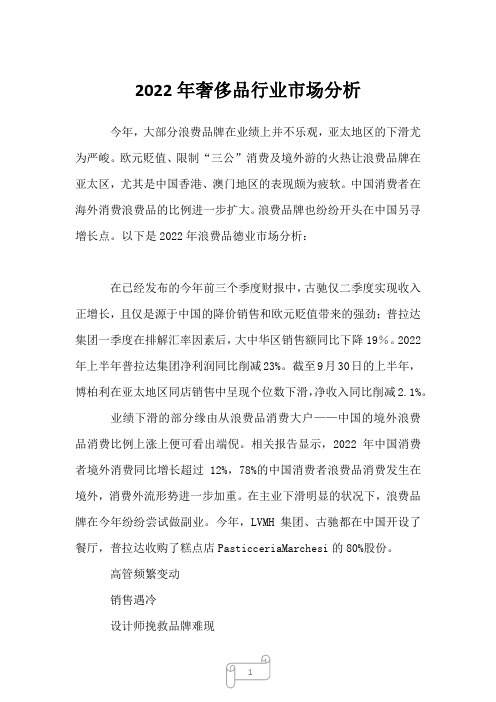
2022年奢侈品行业市场分析今年,大部分浪费品牌在业绩上并不乐观,亚太地区的下滑尤为严峻。
欧元贬值、限制“三公”消费及境外游的火热让浪费品牌在亚太区,尤其是中国香港、澳门地区的表现颇为疲软。
中国消费者在海外消费浪费品的比例进一步扩大。
浪费品牌也纷纷开头在中国另寻增长点。
以下是2022年浪费品德业市场分析:在已经发布的今年前三个季度财报中,古驰仅二季度实现收入正增长,且仅是源于中国的降价销售和欧元贬值带来的强劲;普拉达集团一季度在排解汇率因素后,大中华区销售额同比下降19%。
2022年上半年普拉达集团净利润同比削减23%。
截至9月30日的上半年,博柏利在亚太地区同店销售中呈现个位数下滑,净收入同比削减2.1%。
业绩下滑的部分缘由从浪费品消费大户——中国的境外浪费品消费比例上涨上便可看出端倪。
相关报告显示,2022年中国消费者境外消费同比增长超过12%,78%的中国消费者浪费品消费发生在境外,消费外流形势进一步加重。
在主业下滑明显的状况下,浪费品牌在今年纷纷尝试做副业。
今年,LVMH集团、古驰都在中国开设了餐厅,普拉达收购了糕点店PasticceriaMarchesi的80%股份。
高管频繁变动销售遇冷设计师挽救品牌难现行业管理难度加大盛世太平的浪费品牌在颓势时纷纷面临着高管的动荡。
今年仅古驰就经受了多起人事变动,古驰首席执行官Patrizio di Marco及创意总监FridaGiannini双双离任;迪奥女装创意总监Raf Simons 宣布辞任;巴黎世家创意总监Alexander Wang离任。
无论是高管的动荡还是创意总监的更迭,无疑都让品牌将来的进展陷入未知。
继去年3月前首席执行官BrunoGuillon辞职后,该老牌皮具品牌经受了一年没有CEO的尴尬时期。
Bruno Guillon曾任职于爱马仕,迈宝瑞挖脚BrunoGuillon的初衷也是寄盼望于他能将迈宝瑞重塑成另一个高端小众的爱马仕。
- 1、下载文档前请自行甄别文档内容的完整性,平台不提供额外的编辑、内容补充、找答案等附加服务。
- 2、"仅部分预览"的文档,不可在线预览部分如存在完整性等问题,可反馈申请退款(可完整预览的文档不适用该条件!)。
- 3、如文档侵犯您的权益,请联系客服反馈,我们会尽快为您处理(人工客服工作时间:9:00-18:30)。
摘要近年来,奢侈品消费与贸易在全球呈上升之势,其中中国因素起着重要作用。
根据世界奢侈品协会的数据显示,世界奢侈品市场的增长率至少是全球经济增长率的两倍,奢侈品产业的蓬勃发展,不但表现在消费文化相对成熟的欧美国家,在发展中国家,例如中国、巴西、印度和俄罗斯等国家,奢侈品更是被新富阶层的消费者所热义和向往,甚至达到一种迷恋的程度。
2010年,我国的奢侈品消费额达到1556亿元,增长率高送10.35%。
根据麦肯锡咨询么司的预测中国可能将在2015年成为全球奢侈品的第一大消费国。
虽然奢侈品的消费会促进我国的经济增长,增加我国的就业人数,但是我们化要看到,在这种奢侈品消费的热潮之后,逐有一些其他的问题也随之出现。
中国是一个奢侈品的进口大国,全世界前100强的奢侈品的品牌中国一个化没有,现在国内消费的奢侈品的品牌化乎全部的来自于国外的进口,一方面造成了我国自已的奢侈品品牌巧竞争为得不到提升,另一方面,由于关税巧原因导致了很多的国内奢侈品消费得到了流失,它们都通过境外消费等的方式流向了国外。
因此,在这种背景之下,探讨我国奢侈品消费的驱动机制,进而研究我国奢侈品贸易及政策选择,并为促进我国自主奢侈品品牌发展提供参考,都有着十分重要的理论和现实意义。
关键词: 奢侈品; 消费行为; 奢侈品贸易; 中国奢侈品品牌AbstractSmall and medium-sized enterprise is an important part of the national economy, with its unique mode of operation and flexible production methods for economic development and social stability plays an important role in promoting. The small and medium-sized enterprises are quite part ignored in the financial management of the key position, and management thoughts, make enterprise administration rigid backward production operational management pattern to the role of enterprise financial management, no into full play. Meanwhile, the macroeconomic environment, due to the influence of changes and system, and small and medium-sized enterprises in strengthening financial management encountered some resistance.Here mainly from the small and medium-sized enterprises in financial management present situation, the modern financial management as the basis, through the analysis of the small and medium-sized enterprises, to find out the problems existing in the financial management, and to find out the causes of the existing problems and discusses the development of small and middle-sized enterprises financial management methods, improve financial management mechanism and enhance small and medium-sized enterprise management level. On this foundation, discuss enterprise under the new situation the development direction of financial management.Key words : Luxury ; Consumer behavior; Luxury trade; Chinese luxury brands绪论改革开放年来,随着中国经济的快速发展,居民收入水平的大幅增长,富裕人群的快速涌现,中国正逐步成为奢侈品消费市场的生力军。
尤其是年中国加入及年消费首次超过投资成为拉动我国增长的第一因素之后,中国正成为最具潜力的奢侈品消费大国。
中国的奢侈品消费始于上世纪九十年代初,并且在近些年得到飞速的发展。
据世界奢侈品协会的数据显示,年中国奢侈品市场的规模达到亿美元占全球市场份额的,消费人群达到总人口的,成为仅次于日本和美国的世界第三大奢侈品消费大国。
年,中国奢侈品消费总额达到亿美元,占全球市场份额的,首次超过美国成为继日本之后的世界第二大奢侈品消费国。
中国奢侈品市场的快速发展暴露出奢侈品进出口贸易方面存在着许多问题,中国奢侈品进出口贸易研究对发现问题、解决问题将具有重要意义。
1奢侈品概述及市场现状1.1奢侈品的概述奢侈品在国际上被定义为“一种超出人们生存与发展需要范围的,具有独特、稀缺、珍奇等特点的消费品”,又成为非生活必需品。
在经济学上讲,奢侈品指的是价值/品质关系比值最高的产品。
从另外一个角度上看,奢侈品又是指无形价值或有形价值关系比值最高的产品[1]。
1.2中国奢侈品市场现状中国改革开放三十年的发展使得中国经济保持稳定快速增长、宏观经济发展形势良好,年至今中国经济每年增长率都超过,经济的发展使得中国百万富翁与亿万富翁的人数持续增加。
据胡润市场调查报告显示,年中国百万富翁人数比年增加了,物业价值上升、股票市场复苏、国内经济的强劲增长催生了一个拥有亿人口的庞大财富群体[2]。
2中国奢侈品贸易的发展状况及趋势2.1中国奢侈品贸易的发展历史及现状2.1.1中国奢侈品贸易总额的变化根据中国商务部预计,到2015年,中国将有2.5亿消费者有能力购买奢侈品,这将是目前的17倍。
也有一些分析人士预言,中国到2015年会成为世界第一大奢侈品的消费国。
根据相关资料显示,未來5年内将有2.3亿人口进入有奢侈品专卖店的城市,从而进一步带动奢侈品消费市场的成长与发展。
2008年我国奢侈品消费的总额是1410亿人民币,2009年的奢侈品消费的总额是1556亿人民币,增长率是8%。
2008年到2009年国内的奢侈品消费的总额由602亿人民币増长到了648亿人民币,增长率是14%。
所以说国内的奢侈品的消费增长速度比国外的奢侈品的消费增长快。
这也反映出来我国奢侈品进口的增长率有所提高[3]。
2.1.2中国奢侈品贸易的经济地位从我国奢侈品市场上的奢侈品的主要需求方面来看,我国现阶段的奢侈品消费者大部分还集中在对巧级的奢侈品消费的需求,属于“商品驱动型消费”,而欧美等发达国家却是一种生活习惯的向往,追求的是通过个人效用。
而且我国的奢侈品消费者不懂得如何消费,面子消费和炫耀型消费问题严重。
现阶段我国的经济正在发展,并且国家正在不断的调整经济结构转变现阶段的经济增长方式,拉动内需是现阶段发展经济的重中之重。
虽然促进奢侈品的消费与我国传统的勤俭节约观念不符,但是在一定的可W接纳的范围之内,促进奢侈品的消费会拉动内需,缩小贫富之间的差距,对我国的经济发展有一定的正向作用[4]。
2.2中国奢侈品贸易的特点2.2.1中国奢侈品的进口贸易中国作为新兴的国际第二大经济体,特别是中国加入世界贸易組织后中国放宽奢侈品进口口槛,国外众多奢侈品牌纷纷抢滩中国市场。
根据商务部2010年发布的数据显示,中国进口奢侈品的贸易量322亿元人民币位居世界第二,仅次于日本。
我国奢侈品消费群比欧、美、日年轻。
我国的富裕消费群体与国外富裕消费群相比明显年轻,根据2009年的《2009胡润财富报告》可以看出,我国身价过亿元及千万富翁的富裕人士平均年龄分别为43岁和39岁。
此外,包括一些富二代及年轻创业家,高级白领在内的80后消费群体也逐渐引起人们的关注,他们对奢侈品的认知程度和消费能力都较島。
男性为中国奢侈品消费群体主力。
据中国品牌战略协会的报告,与海外市场明显不同的是,我国奢侈品消费群体男性为主导,其主要消费群体是年轻企业家,行业精英,名人等。
北京庄胜的崇光百货就把消费群体进行细分,开辟出专口出售男装的“绅士馆”,即使如此,女性消费力量仍然不可忽视,2010年奢侈品消费总额比2008年增长80%,其对化妆品、珠宝、箱包等的消费能力正不断提升[5]。
2.2.2 中国奢侈品的出口贸易目前我国自己设计和生产的奢侈品品牌分布状况除了一部分高档的珠宝配饰晶有一定的市场占有率之外,我国本土上奢侈品市场上消费的本国的奢侈品品牌多集中在白酒、茶叶和服装等中国传统的奢侈品行业中。
与发达国家相比,我国的奢侈品行业的发展还处于发展的初级阶段,只是奢侈品消费数量的增长,自主的奢侈品品牌的培育还是不足,奢侈品行业市场中各奢侈品的生产企业规模明显偏小,行业分散,地区分散,与发达国家相比还有较大的距离[6]。
2.3中国奢侈品贸易的发展趋势2.3.1奢侈品产业的发展创造就业和财富消费者购买奢侈品并不仅仅是追求其品质和功能,更主要是因为奢侈品代表了其身份地位,这就形成了奢侈品的一个特性,能够引发人们额外的需求和购买欲望。
由于奢侈品消费市场和生产市场的不断发展,并且大多数奢侈品完全由手工打制而成,这就为生产地带来了很多就业机会。
很多奢侈品公司都是大型跨国公司,在世界各地拥有生产基地和销售公司。
如果没有这些奢侈品,就没有这些奢侈品公司,那么将有更多的人失业。
正是由于奢侈品行业的存在和发展,才使更多的人获得了就业机会,增加了社会财富。
2.3.2 奢侈品产业的发展刺激消费当前,我国经济的突出问题就是结构性生产过剩,有效需求不足,而我国奢侈品消费市场的不断发展,一定程度上带动了我国的消费。
所以,奢侈品产业的发展刺激了消费、创造了就业机会,也促进了财富的积累。
从经济学的观点来看,富人的奢侈型消费也有其积极作用。
奢侈是一种高倍数的需求,奢侈型消费是普通消费的多倍。
3 中国奢侈品消费与贸易成长的成因分析3.1宏观因素3.1.1区位因素区位优势是指一个国家能为来境内从事生产活动或者其他经济活动的公司或者行业提供的便利条件。
